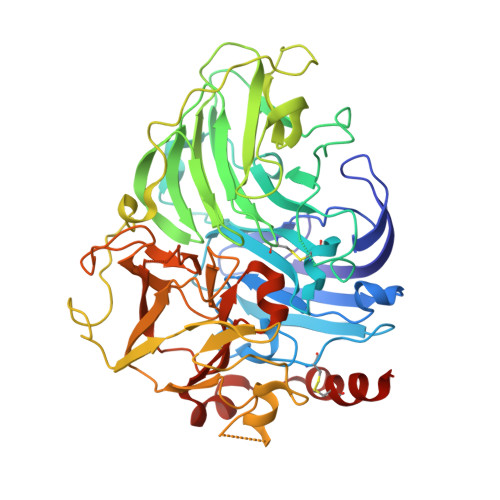Advanced Synthesis of Conductive Polyaniline Using Laccase as Biocatalyst.
de Salas, F., Pardo, I., Salavagione, H.J., Aza, P., Amougi, E., Vind, J., Martinez, A.T., Camarero, S.(2016) PLoS One 11: e0164958
- PubMed: 27741301
- DOI: https://doi.org/10.1371/journal.pone.0164958
- Primary Citation of Related Structures:
6H5Y - PubMed Abstract:
Polyaniline is a conductive polymer with distinctive optical and electrical properties. Its enzymatic synthesis is an environmentally friendly alternative to the use of harsh oxidants and extremely acidic conditions. 7D5L, a high-redox potential laccase developed in our lab, is the biocatalyst of choice for the synthesis of green polyaniline (emeraldine salt) due to its superior ability to oxidize aniline and kinetic stability at the required polymerization conditions (pH 3 and presence of anionic surfactants) as compared with other fungal laccases. Doses as low as 7.6 nM of 7D5L catalyze the polymerization of 15 mM aniline (in 24 h, room temperature, 7% yield) in the presence of different anionic surfactants used as doping templates to provide linear and water-soluble polymers. Aniline polymerization was monitored by the increase of the polaron absorption band at 800 nm (typical for emeraldine salt). Best polymerization results were obtained with 5 mM sodium dodecylbenzenesulfonate (SDBS) as template. At fixed conditions (15 mM aniline and 5mM SDBS), polymerization rates obtained with 7D5L were 2.5-fold the rates obtained with commercial Trametes villosa laccase. Moreover, polyaniline yield was notably boosted to 75% by rising 7D5L amount to 0.15 μM, obtaining 1g of green polyaniline in 1L-reaction volume. The green polymer obtained with the selected system (7D5L/SDBS) holds excellent electrochemical and electro-conductive properties displayed in water-dispersible nanofibers, which is advantageous for the nanomaterial to be readily cast into uniform films for different applications.
Organizational Affiliation:
Centro de Investigaciones Biológicas, CSIC, Ramiro de Maeztu 9, 28040, Madrid, Spain.

















